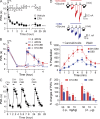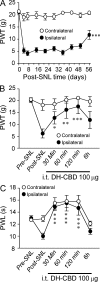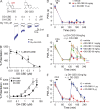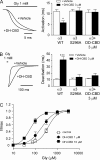Cannabinoids suppress inflammatory and neuropathic pain by targeting α3 glycine receptors
- PMID: 22585736
- PMCID: PMC3371734
- DOI: 10.1084/jem.20120242
Cannabinoids suppress inflammatory and neuropathic pain by targeting α3 glycine receptors
Abstract
Certain types of nonpsychoactive cannabinoids can potentiate glycine receptors (GlyRs), an important target for nociceptive regulation at the spinal level. However, little is known about the potential and mechanism of glycinergic cannabinoids for chronic pain treatment. We report that systemic and intrathecal administration of cannabidiol (CBD), a major nonpsychoactive component of marijuana, and its modified derivatives significantly suppress chronic inflammatory and neuropathic pain without causing apparent analgesic tolerance in rodents. The cannabinoids significantly potentiate glycine currents in dorsal horn neurons in rat spinal cord slices. The analgesic potency of 11 structurally similar cannabinoids is positively correlated with cannabinoid potentiation of the α3 GlyRs. In contrast, the cannabinoid analgesia is neither correlated with their binding affinity for CB1 and CB2 receptors nor with their psychoactive side effects. NMR analysis reveals a direct interaction between CBD and S296 in the third transmembrane domain of purified α3 GlyR. The cannabinoid-induced analgesic effect is absent in mice lacking the α3 GlyRs. Our findings suggest that the α3 GlyRs mediate glycinergic cannabinoid-induced suppression of chronic pain. These cannabinoids may represent a novel class of therapeutic agents for the treatment of chronic pain and other diseases involving GlyR dysfunction.
Figures









Similar articles
-
Involvement of glycine receptor α1 subunits in cannabinoid-induced analgesia.Neuropharmacology. 2018 May 1;133:224-232. doi: 10.1016/j.neuropharm.2018.01.041. Epub 2018 Feb 1. Neuropharmacology. 2018. PMID: 29407767
-
A common molecular basis for exogenous and endogenous cannabinoid potentiation of glycine receptors.J Neurosci. 2012 Apr 11;32(15):5200-8. doi: 10.1523/JNEUROSCI.6347-11.2012. J Neurosci. 2012. PMID: 22496565 Free PMC article.
-
Cholesterol regulates cannabinoid analgesia through glycine receptors.Neuropharmacology. 2020 Oct 15;177:108242. doi: 10.1016/j.neuropharm.2020.108242. Epub 2020 Jul 24. Neuropharmacology. 2020. PMID: 32712277
-
Glycine receptors: a new therapeutic target in pain pathways.Curr Opin Investig Drugs. 2006 Jan;7(1):48-53. Curr Opin Investig Drugs. 2006. PMID: 16425671 Review.
-
Current evidence of cannabinoid-based analgesia obtained in preclinical and human experimental settings.Eur J Pain. 2018 Mar;22(3):471-484. doi: 10.1002/ejp.1148. Epub 2017 Nov 21. Eur J Pain. 2018. PMID: 29160600 Review.
Cited by
-
Human Hyperekplexic Mutations in Glycine Receptors Disinhibit the Brainstem by Hijacking GABAA Receptors.iScience. 2019 Sep 27;19:634-646. doi: 10.1016/j.isci.2019.08.018. Epub 2019 Aug 13. iScience. 2019. PMID: 31450193 Free PMC article.
-
The use of cannabis in supportive care and treatment of brain tumor.Neurooncol Pract. 2017 Sep;4(3):151-160. doi: 10.1093/nop/npw027. Epub 2017 Jan 18. Neurooncol Pract. 2017. PMID: 31385997 Free PMC article. Review.
-
Glycine: The Smallest Anti-Inflammatory Micronutrient.Int J Mol Sci. 2023 Jul 8;24(14):11236. doi: 10.3390/ijms241411236. Int J Mol Sci. 2023. PMID: 37510995 Free PMC article. Review.
-
Topical Cannabinoids for Treating Chemotherapy-Induced Neuropathy: A Case Series.Integr Cancer Ther. 2021 Jan-Dec;20:15347354211061739. doi: 10.1177/15347354211061739. Integr Cancer Ther. 2021. PMID: 34841942 Free PMC article.
-
Open-channel structures of the human glycine receptor α1 full-length transmembrane domain.Structure. 2013 Oct 8;21(10):1897-904. doi: 10.1016/j.str.2013.07.014. Epub 2013 Aug 29. Structure. 2013. PMID: 23994010 Free PMC article.
References
-
- Ahrens J., Leuwer M., Demir R., Krampfl K., de la Roche J., Foadi N., Karst M., Haeseler G. 2009b. Positive allosteric modulatory effects of ajulemic acid at strychnine-sensitive glycine alpha1- and alpha1beta-receptors. Naunyn Schmiedebergs Arch. Pharmacol. 379:371–378 10.1007/s00210-008-0366-8 - DOI - PubMed
Publication types
MeSH terms
Substances
Grants and funding
LinkOut - more resources
Full Text Sources
Other Literature Sources
Medical
Molecular Biology Databases

